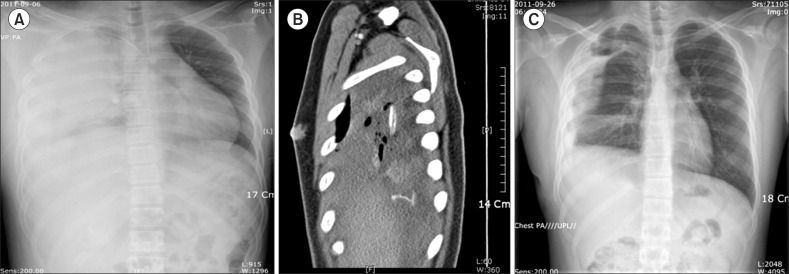Blood Res.
2013 Dec;48(4):282-286. 10.5045/br.2013.48.4.282.
Sequential therapy with activated prothrombin complex concentrates and recombinant activated factor VII to treat unresponsive bleeding in patients with hemophilia and inhibitors: a single center experience
- Affiliations
-
- 1Department of Pediatrics, Kyung Hee University Hospital at Gangdong, School of Medicine, Kyung Hee University, Seoul, Korea. pysmd@khnmc.or.kr
- KMID: 2172876
- DOI: http://doi.org/10.5045/br.2013.48.4.282
Abstract
- BACKGROUND
Currently, the greatest challenge in hemophilia treatment is managing hemophilia patients with inhibitors. The two main bypassing agents that are used to treat hemophilia patients with inhibitors are activated prothrombin complex concentrates (APCC) and recombinant factor VIIa (rFVIIa). Hemophilia patients with inhibitors can develop bleeding episodes, that are refractory to monotherapy with either APCC or rFVIIa and thus are often difficult to manage.
METHODS
This report describes a retrospective chart review of four hospitalized patients with severe hemophilia and inhibitors who were treated with sequential therapy of APCC and rFVIIa for refractory bleeding. Sequential therapy was defined as the administration of both rFVIIa and APCC within 12 h.
RESULTS
In 5 episodes experienced by 4 patients with inhibitors, bleeding was not controlled by single bypass treatment, but it was controlled when two agents were sequentially administered. Sequential therapy was administered by alternating one APCC dose to 1 to 2 rFVIIa doses, with dosing intervals ranging from 3 to 6 h. All bleeding episodes were controlled within 12 to 24 h. Sequential therapy was discontinued after 2 to 5 days. No adverse clinical events, such as thrombosis, were observed.
CONCLUSION
Sequential therapy with APCC and rFVIIa was efficacious without adverse events; however, attention on thrombosis is needed. In addition, a prospective clinical trial is needed to provide further evidence for this treatment.
Keyword
MeSH Terms
Figure
Cited by 2 articles
-
Attempts to treat patients with hemophilia, the "royal disease"
Rojin Park
Blood Res. 2013;48(4):235-236. doi: 10.5045/br.2013.48.4.235.The efficacy of bypassing agents in surgery of hemophilia patients with inhibitors
Hee Young Ju, Hye Lim Jang, Young Shil Park
Blood Res. 2015;50(3):173-178. doi: 10.5045/br.2015.50.3.173.
Reference
-
1. Mannucci PM, Tuddenham EG. The hemophilias-from royal genes to therapy. N Engl J Med. 2001; 344:1773–1779. PMID: 11396445.2. Gringeri A, Mantovani LG, Scalone L, Mannucci PM. Cost of care and quality of life for patients with hemophilia complicated by inhibitors: the COCIS Study Group. Blood. 2003; 102:2358–2363. PMID: 12816859.
Article3. Lloyd-Jones M, Wight J, Paisley S, Knight C. Control of bleeding in patients with haemophilia A with inhibitors: a systematic review. Haemophilia. 2003; 9:464–520. PMID: 12828680.4. Korea Hemophilia Foundation: Annual report 2012. Seoul, Korea: KHF;2012. p. 16.5. Ingerslev J, Sorensen B. Parallel use of by-passing agents in haemophilia with inhibitors: a critical review. Br J Haematol. 2011; 155:256–262. PMID: 21895627.
Article6. Teitel J, Berntorp E, Collins P, et al. A systematic approach to controlling problem bleeds in patients with severe congenital haemophilia A and high-titre inhibitors. Haemophilia. 2007; 13:256–263. PMID: 17498074.
Article7. Berntorp E. Differential response to bypassing agents complicates treatment in patients with haemophilia and inhibitors. Haemophilia. 2009; 15:3–10. PMID: 19016901.
Article8. Schneiderman J, Nugent DJ, Young G. Sequential therapy with activated prothrombin complex concentrate and recombinant factor VIIa in patients with severe haemophilia and inhibitors. Haemophilia. 2004; 10:347–351. PMID: 15230948.
Article9. Schneiderman J, Rubin E, Nugent DJ, Young G. Sequential therapy with activated prothrombin complex concentrates and recombinant FVIIa in patients with severe haemophilia and inhibitors: update of our previous experience. Haemophilia. 2007; 13:244–248. PMID: 17498072.
Article10. Lusher JM. Inhibitor antibodies to factor VIII and factor IX: management. Semin Thromb Hemost. 2000; 26:179–188. PMID: 10919411.
Article11. Lusher JM. Inhibitors in young boys with haemophilia. Baillieres Best Pract Res Clin Haematol. 2000; 13:457–468. PMID: 11030045.
Article12. Negrier C, Dargaud Y, Bordet JC. Basic aspects of bypassing agents. Haemophilia. 2006; 12(Suppl 6):48–53. PMID: 17123394.
Article13. Young G, Blain R, Nakagawa P, Nugent DJ. Individualization of bypassing agent treatment for haemophilic patients with inhibitors utilizing thromboelastography. Haemophilia. 2006; 12:598–604. PMID: 17083509.
Article14. Hayashi T, Tanaka I, Shima M, et al. Unresponsiveness to factor VIII inhibitor bypassing agents during haemostatic treatment for life-threatening massive bleeding in a patient with haemophilia A and a high responding inhibitor. Haemophilia. 2004; 10:397–400. PMID: 15230956.
Article15. Watts RG. Successful use of recombinant factor VIIa for emergency fasciotomy in a patient with hemophilia A and high-titer inhibitor unresponsive to factor VIII inhibitor bypassing activity. Am J Hematol. 2005; 79:58–60. PMID: 15849767.
Article16. Varadi K, Negrier C, Berntorp E, et al. Monitoring the bioavailability of FEIBA with a thrombin generation assay. J Thromb Haemost. 2003; 1:2374–2380. PMID: 14629472.
Article
- Full Text Links
- Actions
-
Cited
- CITED
-
- Close
- Share
- Similar articles
-
- Post-operative Bleeding due to Acquired Hemophilia Successfully Treated with Recombinant Factor VIIa: Case Report
- Laparoscopic Cholecystectomy in a Hemophiliac Patient with Factor VIII Inhibitor
- The efficacy of bypassing agents in surgery of hemophilia patients with inhibitors
- A case of intracranial hemorrhage in a neonate with congenital factor VII deficiency
- A Case of Successful Treatment of Childhood Intractable Gastrointestinal Hemorrhage with Low Dose Recombinant Activated Factor VII (NovoSeven (R))


